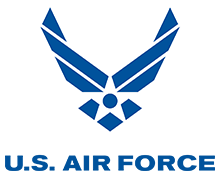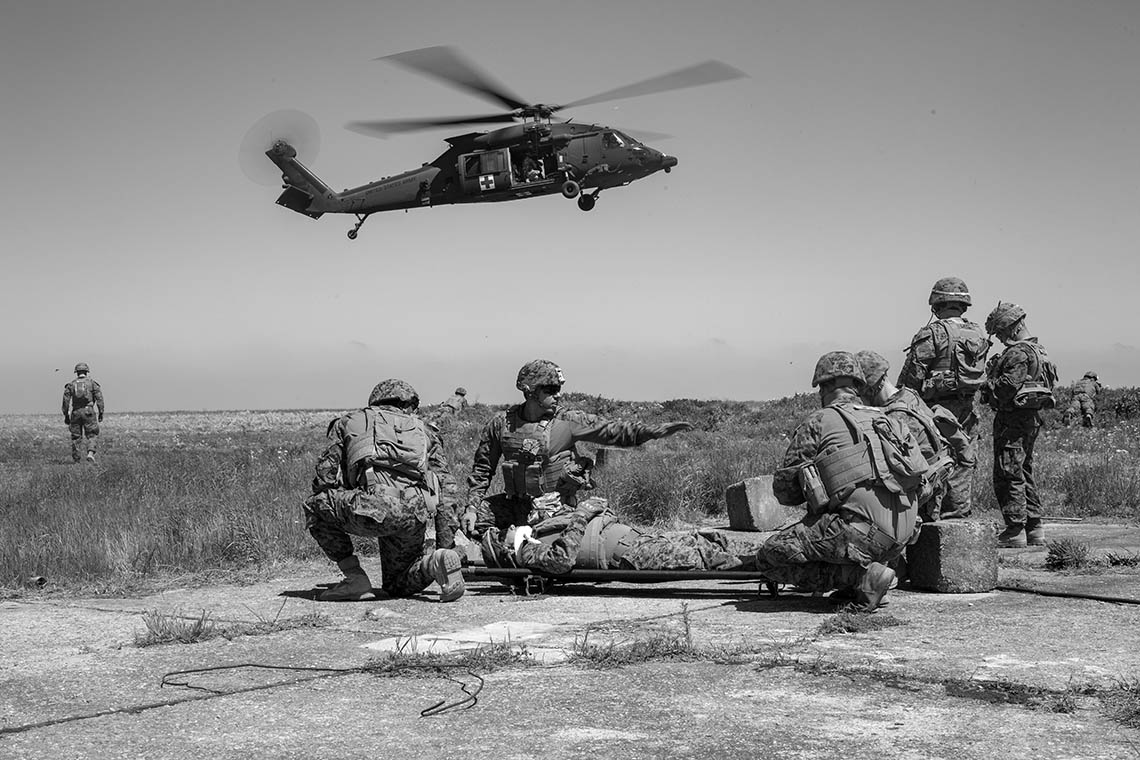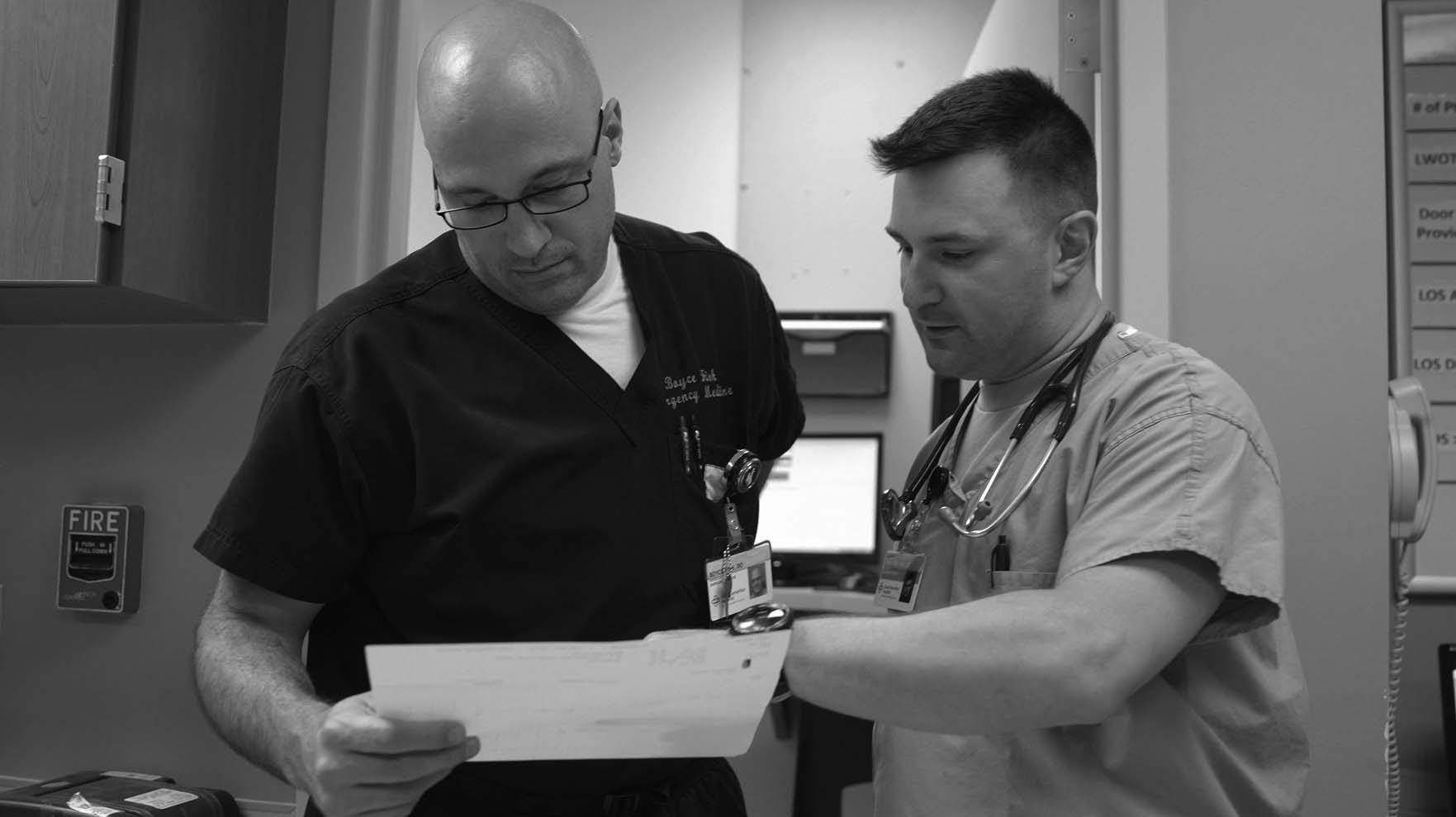- FAQs
- |

John Trentini, M.D., Ph.D.
Emergency Medicine Resident
- Service Branch: Air Force
- Location: Wright-Patterson Air Force Base
- Specialty: Emergency Medicine
Air Force Major John Trentini is training as an emergency medicine resident at Good Samaritan Hospital in Dayton, Ohio. As part of his residency, he also participates in nanoparticle research at the Kettering Medical Center. When he’s not working, John tends to several animals on his 10-acre farm.
”Emergency medicine, in my opinion, is the best medical specialty because it’s the most interesting. It’s the most fun.“
Air Force Major John Trentini is training as an emergency medicine resident at Good Samaritan Hospital in Dayton, Ohio. As part of his residency, he also participates in nanoparticle research at the Kettering Medical Center. When he’s not working, John tends to several animals on his 10-acre farm.
”Emergency medicine, in my opinion, is the best medical specialty because it’s the most interesting. It’s the most fun.“
01:22AM
"Tonight I had to order an EKG for the patient that we put on cardiac alert. This is the cardiac monitor and it shows you where to connect EKG leads."
"Tonight I had to order an EKG for the patient that we put on cardiac alert. This is the cardiac monitor and it shows you where to connect EKG leads."
03:10AM
Emergency Medicine Residency Rotations
John explains the joint residency program between Wright-Patterson Air Force Base and Wright State University. The program is split 50/50 between military and civilian residents, and the majority of his rotations are at civilian hospitals in the Dayton area.
Emergency Medicine Residency Rotations
John explains the joint residency program between Wright-Patterson Air Force Base and Wright State University. The program is split 50/50 between military and civilian residents, and the majority of his rotations are at civilian hospitals in the Dayton area.
TRENTINI: The residency program here at Wright State and at Wright Patterson Air Force Base, it’s a kind of a combination program between civilian and Military. It’s 50/50. So we’re side-by-side with civilian residents, and we do the majority of our rotations down at civilian hospitals. So this month in particular I’m here at Good Sam, which is sort of our inner-city, urban hospital, sort of our underserved community. You see a lot of acuity here, a lot of very sick people. We do rotations here, we do rotations at Miami Valley, at the level-one trauma center. We do rotations at Kettering and at Sycamore, as well as rotations at the base as well.
06:00AM
Emergency Medicine Residency Overnight Shift
John's day-to-day medical service is very similar to his civilian colleagues. He goes on rotations, is mentored by attending physicians and receives on-the-spot training. During his overnight shift at Good Samaritan Hospital, John sees a patient who he puts on cardiac alert. The fast-paced, unexpected nature of emergency medicine is preparing him for a career in the Military.
Emergency Medicine Residency Overnight Shift
John's day-to-day medical service is very similar to his civilian colleagues. He goes on rotations, is mentored by attending physicians and receives on-the-spot training. During his overnight shift at Good Samaritan Hospital, John sees a patient who he puts on cardiac alert. The fast-paced, unexpected nature of emergency medicine is preparing him for a career in the Military.
TRENTINI: Being an emergency medicine resident, we train in the most part in civilian hospitals — from the Air Force’s perspective is to train a good emergency department physician.
TRENTINI: So it’s about — about ten to 11:00 or so now, so getting ready to start our night. Kind of always take a peek at all the rooms, see what’s going on in the way in. These are some of the higher-acuity rooms, so if there’s anybody that’s real sick that needs some help right away, I can always peek in, but everybody looks pretty stable right now. So we’re getting checked in and settled in here. Hi, sir.
PATIENT: Hi.
TRENTINI: I’m Dr. Trentini. Nice to meet you.
PATIENT: Nice to meet you.
TRENTINI: I’m going to just shake this hand, they’re working on you over there. What brings you in tonight?
PATIENT: I’ve — chest pain. A really bad pressure right here. And I can feel it all the way down my left arm.
TRENTINI: OK.
PATIENT: It’s almost like somebody’s sitting on my left shoulder.
TRENTINI: OK.
PATIENT: Real bad pressure.
TRENTINI: When did it start?
PATIENT: About — about two hours ago.
TRENTINI: OK.
PATIENT: It started out real slow, and it just got gradually worse and didn’t go away like normal.
TRENTINI: OK. Hey, Dr. Fish? FISH: Hey.
TRENTINI: I’ve got a gentleman that I just put a cardiac alert out on. He is stable, but here’s his EKG. So, I mean, he’s got some ischemic changes here in V2, V3, V4. He’s probably having an anterior wall MIT. Yeah, so when you’re working with an attending, basically you’re working under their supervision, and so for me, I try to practice independently. In my mind, I pretend like they’re not there. So I’m on my own, and I need to make all the medical decisions. But in the back of my mind I know that they’re there, and they’re watching me, and they’re — they’ve got my back.
FISH: His cardio back yet?
TRENTINI: Not yet, we just put out the cardiac alert, so — so I’ll take a look at his chest ray, we’ll push with 5,000 to heparin, put him on a heparin drip, we’ll start him on a nitro drip, his pressures will tolerate it — his pressure’s been 190 throughout, so.
FISH: Alright.
TRENTINI: And then we’ll get his pain — pain under control.
FISH: Alright, so we’re going to get things taken care of, alright?
PATIENT: Thank you.
TRENTINI: Alright. Alright, sir. I’ll come and check on you in a bit, OK? Let me go and put it — talk to Chuck and get your medicines ordered, OK?
PATIENT: Thank you.
TRENTINI: Alright. Emergency medicine, in my opinion, is the best medical specialty because it’s the most interesting, it’s the most fun — you’ve got to be on your toes — and you take care of people that are pregnant and take care of babies all the way up to 100-year-old patients, with a wide variety of illnesses and a wide variety of acuity as well. So it’s fun, and it’s fast-paced, and so you get to see a lot of people on a shift and you get to see a lot of different things on a shift.
07:27AM
"So where I live is in Sugar Creek, which is a small township just east of Dayton. This is the kind of a place where you can get some land, get some space, and get out of the city a little bit, but still be close enough to everything you need."
"So where I live is in Sugar Creek, which is a small township just east of Dayton. This is the kind of a place where you can get some land, get some space, and get out of the city a little bit, but still be close enough to everything you need."
08:21AM
Adopting Farm Animals
John tells the story of how he acquired several farm animals, including chickens, alpacas, sheep and his 160-pound pig, Abigail.
Adopting Farm Animals
John tells the story of how he acquired several farm animals, including chickens, alpacas, sheep and his 160-pound pig, Abigail.
TRENTINI: Well, it’s kind of a funny story. I started out with just chickens, because I like the fresh eggs every day, and then I went to a chicken swap, and then the next guy was selling alpacas for pretty cheap. And so I had the pasture, I had the space, so I said, what the heck. So I got them, and then I got the sheep to kind of mow down the pasture a little bit and eat it down. And they’ve all been kind of living together and having a good time together. And then Abigail, the pig, I rescued. She was supposed to be a miniature pig, only supposed to be about 30 pounds, and now she’s about 160 pounds. So I think I got duped. But it’s OK. She’s part of the family now.
08:47AM
"This is my class of 2013 T-shirt from the Uniformed Services University of the Health Sciences (USUHS). I spent seven years there to earn my M.D. and Ph.D. USUHS is the only medical school in the country where you're going to get dedicated military-specific training. Also, it's free, and you can maintain your salary while you're going to medical school, which is a great perk. Then when you retire from the Military, those four years you were in medical school will get tacked on to your retirement."
"This is my class of 2013 T-shirt from the Uniformed Services University of the Health Sciences (USUHS). I spent seven years there to earn my M.D. and Ph.D. USUHS is the only medical school in the country where you're going to get dedicated military-specific training. Also, it's free, and you can maintain your salary while you're going to medical school, which is a great perk. Then when you retire from the Military, those four years you were in medical school will get tacked on to your retirement."
10:00AM
Life As A Doctor And A Farmer
John lives on a 10-acre farm in Ohio where he has several animals he tends to on a daily basis. When he arrives home from work, he goes outside to clean the barn, feed his animals and shave his alpaca, Carl. His farm is his sanctuary. It's a welcome reprieve from a hectic day in the emergency room.
Life As A Doctor And A Farmer
John lives on a 10-acre farm in Ohio where he has several animals he tends to on a daily basis. When he arrives home from work, he goes outside to clean the barn, feed his animals and shave his alpaca, Carl. His farm is his sanctuary. It's a welcome reprieve from a hectic day in the emergency room.
TRENTINI: You know, a lot of times I’ll work very strange shifts in the ER, where I’ll get home at sometimes midnight or sometimes work an overnight shift and get home at about 8:30 in the morning.
[whistles] Hey, guys. Hey, mister. Hey, Abigail. Hey, Abby girl. You hungry for breakfast?
We’ll usually just have some coffee and a little bit of breakfast, do some reading about some of the cases — interesting cases I saw the night before, and then come out here and check on the animals and get — kind of get the day-to-day things taken care of before passing out (laughter) and going to sleep and getting some rest and getting ready for the next night.
People always ask me why — you know, why farming is — like, why’d you get a farm? You know, you’re doing residency and you’re busy and all this stuff. And I’ve always wanted to have a lot of space and land and I grew up, you know, kind of around farms and cow farms and horse farms and always wondered what it’d be like to have one of my own. They’re really actually not a lot of work, to be honest. It’s just coming out, making sure they’ve got plenty of food, plenty of water. And they’ve got a good pasture out that they eat plenty of grass in, so. Well, after we get this cleaned up a little bit, we’ll put down some fresh bedding, and then I think it’s time for Carl to get a haircut.
I really connect with my patients a lot, because you’d be surprised how many alpaca farmers are in the area here, so it’s not uncommon where I’ll be talking with somebody that’s in the ER who has got a farm, a sheep, or a livestock or something, and sometimes I’ll get advice from my patients in terms of how to do stuff, so — so it’s a great connection with folks in the area here, so. And, you know, I’ve got to take care of these guys just like I take care of my patients, although I will say I’ve never given a haircut to any of my patients in the ER before.
10:27AM
"Here's Carl and me after his haircut. He's still a little wet from the rain."
"Here's Carl and me after his haircut. He's still a little wet from the rain."
10:41PM
"This is Carl's wool we trimmed up, and you can see how soft and warm it looks. It's in a bag now and hopefully I'll spin it down and make some socks. I've never made socks before; we'll play it by ear."
"This is Carl's wool we trimmed up, and you can see how soft and warm it looks. It's in a bag now and hopefully I'll spin it down and make some socks. I've never made socks before; we'll play it by ear."
11:25PM
"This is the 'random resident generator,' and every week our program director spins the wheel, pulls out a number and chooses a resident to do an oral boards case in front of everyone. I got lucky today and was picked."
"This is the 'random resident generator,' and every week our program director spins the wheel, pulls out a number and chooses a resident to do an oral boards case in front of everyone. I got lucky today and was picked."
12:20PM
"During a cardiac arrest, one of the tools you can use is the ultrasound to look at the heart directly to see whether or not it's beating. The equipment that we have here in the simulation center is exactly what you would find in a real emergency room."
"During a cardiac arrest, one of the tools you can use is the ultrasound to look at the heart directly to see whether or not it's beating. The equipment that we have here in the simulation center is exactly what you would find in a real emergency room."
01:13PM
"The control room in the simulation center is where whoever is running the scenario for the residents can speak to them through the microphone and can change the vital signs settings on the mannequin. The operator drives the case throughout the procedure."
"The control room in the simulation center is where whoever is running the scenario for the residents can speak to them through the microphone and can change the vital signs settings on the mannequin. The operator drives the case throughout the procedure."
01:32PM
"In the simulation lab we can practice intubating a patient, which means to put a plastic tube through their vocal cords and secure their airway. In a trauma, if someone has a major injury to the neck or the mouth and you need to protect their airway, this is the way to do it."
"In the simulation lab we can practice intubating a patient, which means to put a plastic tube through their vocal cords and secure their airway. In a trauma, if someone has a major injury to the neck or the mouth and you need to protect their airway, this is the way to do it."
02:00PM
Emergency Medicine Academic Training
Once a week, John attends classes, lectures and conferences that help him prepare for the board exam. In addition, he spends time in the simulation lab training for patient care and in the research lab developing ways nanoparticles can prevent damage caused by an acute stroke. When he returns to active duty, he will use this academic training to identify and solve operational gaps on the battlefield.
Emergency Medicine Academic Training
Once a week, John attends classes, lectures and conferences that help him prepare for the board exam. In addition, he spends time in the simulation lab training for patient care and in the research lab developing ways nanoparticles can prevent damage caused by an acute stroke. When he returns to active duty, he will use this academic training to identify and solve operational gaps on the battlefield.
TRENTINI: Alright, so part of residency is academics, so every Tuesday morning we have a conference where all the residents get together, military and civilian. The first thing on the agenda — there’s always an oral boards case. In that situation, one resident’s called up in front to sit with one of the board examiners, and they go through an oral board case in front of the entire residency program. So it’s a little nervewracking. After that we’ll have some simulation sessions to go through, so busy day today.
The simulation center is about as close as you can get to a real-life patient encounter. All the residents go through multiple sims throughout their career, and you can do — almost everything that you can do on a real patient, you can do in the simulation center. The experiments that we conduct in the lab downstairs are slice culture experiments. And so what we can do then is change the environment to simulate a stroke. This is the brain slice, again, that’s cut like a piece of pepperoni, lying flat on the grate, and what we’re interested in studying is this part of the brain, which is the cerebral cortex, which is the outside of the brain, which in humans is all the sulci and gyri, all the gray matter of the brain, OK? We’re interested in studying these cells and how these cells respond to an acute stroke, and if our nanoparticle treatment can prevent the damage caused by an acute stroke.
I was awarded an ROTC scholarship, which paid for college, and then in return I owed four years of active-duty service to the Air Force. So that’s when I decided to go to USUHS where — it’s a military medical school. There I did my medical degree and also did my Ph.D. degree, and it was entirely funded by the Military. And then after medical school you choose a residency, and so emergency medicine for me fit in perfectly. When I’m done, I’ll go back to an active-duty job using all the knowledge and all the experiences that I’ve built along the way to really serve my country better.
TRENTINI: Alright, so part of residency is academics, so every Tuesday morning we have a conference where all the residents get together, military and civilian. The first thing on the agenda — there’s always an oral boards case. In that situation, one resident’s called up in front to sit with one of the board examiners, and they go through an oral board case in front of the entire residency program. So it’s a little nervewracking. After that we’ll have some simulation sessions to go through, so busy day today.
The simulation center is about as close as you can get to a real-life patient encounter. All the residents go through multiple sims throughout their career, and you can do — almost everything that you can do on a real patient, you can do in the simulation center. The experiments that we conduct in the lab downstairs are slice culture experiments. And so what we can do then is change the environment to simulate a stroke. This is the brain slice, again, that’s cut like a piece of pepperoni, lying flat on the grate, and what we’re interested in studying is this part of the brain, which is the cerebral cortex, which is the outside of the brain, which in humans is all the sulci and gyri, all the gray matter of the brain, OK? We’re interested in studying these cells and how these cells respond to an acute stroke, and if our nanoparticle treatment can prevent the damage caused by an acute stroke.
I was awarded an ROTC scholarship, which paid for college, and then in return I owed four years of active-duty service to the Air Force. So that’s when I decided to go to USUHS where — it’s a military medical school. There I did my medical degree and also did my Ph.D. degree, and it was entirely funded by the Military. And then after medical school you choose a residency, and so emergency medicine for me fit in perfectly. When I’m done, I’ll go back to an active-duty job using all the knowledge and all the experiences that I’ve built along the way to really serve my country better.
02:23PM
"Dr. Li is a research professor at Wright State University, and he works in the lab to handle all the technical aspects of the research. The project I'm working on is called 'The Effects of Nanoceria on Acute Stroke.'"
"Dr. Li is a research professor at Wright State University, and he works in the lab to handle all the technical aspects of the research. The project I'm working on is called 'The Effects of Nanoceria on Acute Stroke.'"
02:45PM
"This is a small incubator that has the same composition of chemicals that your brain is perfused with. I can simulate a stroke by changing the environment and taking away all of the oxygen and all of the sugars. Then we can simulate with medicines or interventions ways that we can prevent damage from that stroke."
"This is a small incubator that has the same composition of chemicals that your brain is perfused with. I can simulate a stroke by changing the environment and taking away all of the oxygen and all of the sugars. Then we can simulate with medicines or interventions ways that we can prevent damage from that stroke."
02:48PM
"What we have here on the TV monitor is connected to the microscope. This is the cortex, which is the outside part of the brain, so we're looking at the cells in the cerebral cortex and how they respond to an acute stroke."
"What we have here on the TV monitor is connected to the microscope. This is the cortex, which is the outside part of the brain, so we're looking at the cells in the cerebral cortex and how they respond to an acute stroke."
03:50PM
Inside A Medical Bag
As an emergency medicine resident, John carries his medical bag with him wherever he goes. He takes a moment to describe what's inside.
Inside A Medical Bag
As an emergency medicine resident, John carries his medical bag with him wherever he goes. He takes a moment to describe what's inside.
TRENTINI: So in here I’ve got my laptop, small textbook, my stethoscope is here, always have a 14-gauge needle, tube of toothpaste. I do happen to carry a headlamp. Here’s a bottle of Motrin. Tongue depressor, some scissors — somebody came over and they were like, “Hey, do you have a tuning fork?” And it’s (inaudible) suture. These are calipers. Airway card. Oh, and a tourniquet, of course. You never know when you’re going to need a tourniquet, so. OK, that’s it.
05:10PM
"I'm chief of a tactical resident interest group, which means I oversee the residents that are involved on local SWAT teams. I help them with their assignments, make sure that they have all the skills that they need, and that they're going to be a good asset to the team that they're assigned to. We do semi-annual skills verification. In a hospital, they have lots of resources, but here they have their skills, knowledge and what they can carry on their backs."
"I'm chief of a tactical resident interest group, which means I oversee the residents that are involved on local SWAT teams. I help them with their assignments, make sure that they have all the skills that they need, and that they're going to be a good asset to the team that they're assigned to. We do semi-annual skills verification. In a hospital, they have lots of resources, but here they have their skills, knowledge and what they can carry on their backs."
05:12PM
"This box contains all of our training supplies. We have a lot of pressure dressings, training tourniquets, airway adjuncts and things that you need to take care of someone out in the field."
"This box contains all of our training supplies. We have a lot of pressure dressings, training tourniquets, airway adjuncts and things that you need to take care of someone out in the field."
05:18PM
Training With A High-Fidelity Mannequin
Meet Moose, John's high-fidelity patient simulator mannequin that he uses for the tactical medical training exercise. Moose can be intubated, pumped full of blood and used to practice applying tourniquets to in any environment.
Training With A High-Fidelity Mannequin
Meet Moose, John's high-fidelity patient simulator mannequin that he uses for the tactical medical training exercise. Moose can be intubated, pumped full of blood and used to practice applying tourniquets to in any environment.
TRENTINI: This is Moose. This is our high-fidelity simulator. He’s a really rough and tough guy who we can intubate, we can start an IV on, we can do assessments on, put tourniquets on, pump him full of fake blood, and it makes it very realistic. And so we’re going to practice both tending to him out in the field and then extricating him out from some difficult environments and taking care of him from the back of a truck, so — should be a good day.
06:25PM
"I set up a hostage rescue situation out in the woods on my farmland. We have Moose on the ground and a simulated sniper situated in the tree stand for a more realistic training exercise."
"I set up a hostage rescue situation out in the woods on my farmland. We have Moose on the ground and a simulated sniper situated in the tree stand for a more realistic training exercise."
07:28PM
"Looks like someone was shot with a paintball during the medical training. This is why it's critical we use safety masks when simulating care under fire."
"Looks like someone was shot with a paintball during the medical training. This is why it's critical we use safety masks when simulating care under fire."
08:00PM
Tactical Medic Training Exercise
At the end of the day, John hosts a tactical medical training exercise on his farm. Teams of emergency medicine residents get together to simulate a hostage situation in which an officer is shot while trying to make a rescue. The training is focused on medical care in the field vs. medical care in the hospital.
Tactical Medic Training Exercise
At the end of the day, John hosts a tactical medical training exercise on his farm. Teams of emergency medicine residents get together to simulate a hostage situation in which an officer is shot while trying to make a rescue. The training is focused on medical care in the field vs. medical care in the hospital.
TRENTINI: One of the things that this residency program has, one of the components of it that’s pretty unique, I think, is the tactical medicine program that we have that allows especially the military residents to at least keep a feel in terms of tactical field care. It allows you to keep your skills honed and keep your skills sharp. You know, when we’re here in the emergency department, we have all of our tools, I’ve got a respiratory therapist, I’ve got nurses, I’ve got technicians — well, when you’re out at a house serving a warrant and a police officer gets shot and you’ve got to go in and provide point of care — point of field care, you’ve got to carry everything that you have with you. So we want guys practicing their skills with kind of limited resources. Welcome to our semiannual skills verification training. So you guys are all active members of the tactical residents’ interests group. You all have team assignments. You’ve all been out on operations and training. This is a chance for us to kind of practice our skills and polish up what you norm — what you know, and work under a little bit of stress. I’m going to be out in the woods, and Dr. Springer’s going to be out in the woods as well. We’re going to have orange vests on. That means we are not in play. We are facilitating the exercise. So when you get out there and you see a casualty that you’ve got to attend to, and you say “Is he breathing?” — it’s going to be Moose, OK, so it’s going to be the mannequin — so you’re going to go and assess him, and you’re going to say, “OK, I’m assessing is he breathing?” And I’m going to tell you, “He’s breathing, he’s not breathing,” OK? And then based on what I tell you, do what you need to do.
MALE: We need a medic.
TRENTINI: Medic. Yeah, breath sounds, he’s unconscious, he’s bleeding in his right arm and his right thigh. What else do you have? What else could you bind that thigh with?
MALE 1: Thigh wound is up at the groin.
MALE 2: I gotta pack in.
MALE 1: There you go, now you’re getting it.
TRENTINI: The bleeding is starting to slow down now. So go, go, go, go, go. Get him out of there, guys, get him out of there. Get him into the trail. Let me know when you guys have the airway secure and IV access.
MALE 1: He’s got a second chest wound as well.
TRENTINI: Doc, you ready to move?
MALE 2: Supracranial bleeding?
MALE 1: Alrighty, go.
TRENTINI: Let’s get to the hospital now. All right, guys, end exercise. Good job. So Mike, you had a nice low crawl in, and then Doug finally got his butt down and you got out to him, and, you know, your goal is just to get him, get him out of there. Just drag him out, do whatever it takes, just drag them out of there. And best-case scenario, there would just be peppering, peppering, peppering, peppering, you’re dragging, dragging and dragging to cover. So — so that was good. And then you guys just kind of — you kind of just scooped and ran. You threw a tourniquet on and you ran. I had a hard time catching up with you — you guys were really fast. So that was good. Let’s take a break, and we’ll set up another scenario. So get your headlamps and get everything you need for nighttime operations, OK? Any questions? Alright. Break.
09:10PM
Grilling Hamburgers
After a long day of work, farm chores, classes and training, John relaxes around the fire with his friends.
Grilling Hamburgers
After a long day of work, farm chores, classes and training, John relaxes around the fire with his friends.
TRENTINI: We’ve been doing tactical medicine training all afternoon, and we’re going to have a quick meal here and then do another night operation. And then after that put our feet up, open some beers, light a bonfire and we’re done. Take it easy and take a break, so.
(laughter) (overlapping dialogue; inaudible) Hear, hear, guys. Here’s to a good day of training.
09:17PM
Dog Trick: Salute
Smiley earns a treat after he salutes John on command.
Dog Trick: Salute
Smiley earns a treat after he salutes John on command.
TRENTINI: Sit. And sit. Present arms [dog barks] Salute. Good boy, good boy.
10:50PM
"So my shift starts at 11 p.m. and I got here a little bit early. I usually grab a cup of coffee and a bite to eat before heading to my workstation. I always hope it's busy when I go to work. It provides me an opportunity to help people and to learn."
"So my shift starts at 11 p.m. and I got here a little bit early. I usually grab a cup of coffee and a bite to eat before heading to my workstation. I always hope it's busy when I go to work. It provides me an opportunity to help people and to learn."
11:15PM
"Right now we're at my workstation looking at a chest X-ray. This is where I access electronic medical records, write my notes and look through patient charts."
"Right now we're at my workstation looking at a chest X-ray. This is where I access electronic medical records, write my notes and look through patient charts."
5 PHYSICIANS. 24 HOURS.











